To Establish Correlation Between Fingerprint Patterns of Convicted and Non-Convicted Criminals
Sakshi Ranjan*
Department of Amity School of Applied Sciences (ASAS), Amity University Haryana, Gurugram, India.
Submission:October 22, 2022;Published:January 19, 2023
*Corresponding author:Sakshi Ranjan, Department of Amity School of Applied Sciences (ASAS), Amity University Haryana, Gurugram, India
How to cite this article:Sakshi R. To Establish Correlation Between Fingerprint Patterns of Convicted and Non-Convicted Criminals. J Forensic Sci & Criminal Inves. 2023; 16(4): 555941 DOI:10.19080/JFSCI.2023.16.555941.
Abstract
A fingerprint is an impression left by the friction ridges of a human finger. The objective is to determine the fingerprint pattern of convicted and non-convicted criminals. The present study was conducted at Fingerprint Bureau, Bihar, Patna. Total subjects included were 1100 convicted and 40 non-convicted including males and females. The data for convicted criminals was collected from the old record slip and the non-convicted data was collected from family members, friends, and neighbors. The fingerprint pattern was divided into whorl, loop, and arches. In which the whorl is the most common pattern found in the right and left hand in case of the convicted criminals. But in non- convicted criminals the pattern differs hence no definite conclusion is possible. When we observe the loop pattern the little finger has the maximum no of loop pattern in convicted and in non-convicted criminals. Similarly, with the arches in both the convicted and non-convicted criminals, the digits differ. Hence there is no marked relationship that can be established with finger pattern. Almost a century after Edward Henry published. The use of fingerprints for personal identification became widespread early in this century. Although fingerprints have been noted and used since antiquity, a 25-year activity secured the adoption of their use for identification [1]. From the study, we observe that in both the right and left hand, the thumb has the most repeated whorl pattern in the case of convicted criminals. The arch pattern is found to be the least. The fingerprint patterns of males and females in non-convicted criminals can be the same or different. In convicted criminals, we observed that there is a variable pattern type in each section with different digits which cannot be a deciding factor [2].
Keywords: Fingerprint; Non-Convicted Criminals; Henry Classification System; Forensic Science
Abbreviations: RT: Right Thumb; RI: Right Index; RM: Right Middle; RR: Right Ring; RL: Right Little; LT: Left Thumb; LI: Left Index; LM: Left Middle; LR: Left Ring; LL: Left Little
Introduction
Fingerprints as an evidence category are one of the oldest and most important in all forensic science. Further, we have reached a point where fingerprint individuality is an article of faith among the public and is almost universally accepted among scientists and forensic scientists, as well. Accordingly, a fingerprint match is widely accepted as certain evidence that identifies a particular person. Still, fingerprint evidence is coming under increasing scrutiny, particularly the methods used to match a print to a person. As we will see, it is more complicated than you might expect [3].
Fingerprints are still the most important unconquered tool for criminal identification. The efficacies of procedure and cost-effectiveness are the reasons which make the fingerprints still the most dependable tool for identification. The analysis of such fingerprints of various population groups may be useful for the prospects of the future. A fingerprint is an impression left by the friction ridges of a human finger. The recovery of partial fingerprints from a crime scene is an important method of forensic science. Moisture and grease on a finger result in fingerprints on surfaces such as glass or metal. Deliberate impressions of entire fingerprints can be obtained by ink or other substances transferred from the peaks of friction ridges on the skin to a smooth surface such as paper. Fingerprint records normally contain impressions from the pad on the last joint of fingers and thumbs, though fingerprint cards also typically record portions of lower joint areas of the fingers [4].
Human fingerprints are detailed, nearly unique, difficult to alter, and durable over the life of an individual, making them suitable as long-term markers of human identity. Fingerprint identification, known as dactyloscopy, is the process of comparing two instances of friction ridge skin impressions Researchers look at the arrangement, shape, size, and number of lines in these fingerprint patterns to distinguish one from another. They also analyze very tiny characteristics called minutiae, which can’t be seen with the naked eye Figure 1 [5].
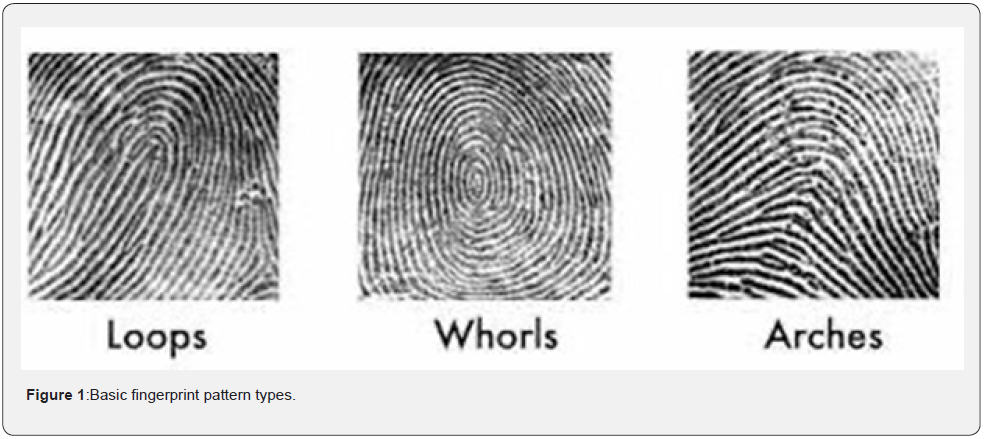
In the Henry Classification System, there are three basic fingerprint patterns: loop, whorl, and arch, which constitute 60-65 percent, 30-35 percent, and 5 percent of all fingerprints respectively. Fingerprint evidence is by far the most effective and reliable evidence in a court of law. Two major aspects which prove the efficiency of fingerprints are, that the ridges formed during the fetal period do not change their course of alignment throughout the life of an individual until the skin is decomposed and the other one is that the two fingerprints of either the same individual or two different individuals are never alike, they differ in their patterns and ridge characteristics. Due to its effectiveness or we can say its potential fingerprints are considered conclusive evidence in the court of law [6].
It has been reported that the characteristic patterns of epidermal ridges are differentiated in their definitive forms during the third and fourth months of fetal life [7]. Dermatoglyphics (ancient Greek, derma= skin, glyph= craving) is the term applied to the scientific study of prints of skin viz., fingerprints, footprints, and palmprints. Fingerprints are characterized by alternating strips of raised friction ridges and depressed grooves on the palmar surface of the fingertips [8].
Methodology
The persons examination included approximate 1100 convicted males & females and 50 non- convicted males & females in the age group 14-45 Yrs. Fingerprints of convicted prisoners were taken from the File of Fingerprint Bureau, Bihar, Patna after obtaining necessary permission from the concerned officials, and the fingerprint patterns of non-convicted criminals were taken from the family members and neighbors. The objectives of the study were explained to all the participants. The materials used were printers, ink pads, sheets of paper, and pens. The subjects were asked to help with their name, age, gender, and type of fingerprint pattern for the study. Some of them were instructed to print with the ink pad as the prints were not clear. The printed sheets with name, age, place, and fingerprint pattern types were distributed. The fingerprint patterns of all the digits were recorded.
The convicted criminals were under major sections under Indian Penal Code with different offences like: 380 IPC (Theft in dwelling house), 411 IPC (Dishonestly receiving stolen property), 379 IPC (Punishment for theft), 457 IPC (Lurking house-trespass or house), 109 CRPC (Security for good behaviour from suspected persons), 109 IPC (Punishment of abetment if the act abetted is committed in consequence and where no express provision is made for its punishment), 409 IPC (Criminal breach of trust by public servant, or by banker, merchant or agent), 489 IPC (Tampering with property mark with intent to cause injury), 381 IPC (Theft by clerk or servant of property in possession of master), 374 IPC (unlawful compulsory labour), 459 IPC (Grievous hurt caused whilst committing lurking house trespass or house-breaking), 486IPC (Selling goods marked with a counterfeit property mark), 427 IPC (Mischief causing damage to the amount of fifty rupees), 147 IPC(Punishment for rioting), 414 IPC (Assisting in concealment of stolen property), 395 IPC (Punishment for dacoity).
The sample size of the convicted and the non-convicted male and female are noted on a sheet of paper and then analyzed one by one. All the digits of the convicted and non-convicted criminals were numbered starting from thumb (T), index finger (I), middle finger (M), ring finger(R), and little finger (L) for both the hands. The digits of the right (R) and left (L) hand side were connoted as RT, RI, RM, RR, RL and LT, LI, LM, LR, LL respectively. Digits were denoted as RT (right thumb) RI (right index) RM (right middle) RR (right ring) RL (right little) and LT (left thumb) LI (left index) LM (left middle) LR (left ring) LL (left little) depending on the side of the digit. Fingerprint patterns were determined by the three basic types of fingerprint patterns Loops, Whorls, Arches. of all the 10 digits of the left hand and the right hand. The subtypes of the fingerprint pattern like in whorl double loop, twinned loop, and central pocket loop, in loop ulnar and radial, and in the arch, the plain and tented arch was analyzed. The following parameters were studied and analyzed: The data of each fingerprint pattern was tabulated, and the percentage of each pattern was calculated. Some of the major sentences were studies along with their percentage. The data between the convicted were studied along with the male-female in non-convicted criminals.
Result
The fingerprint sample of 1100 subjects with left and right hands were collected with all 10 digits. Hence, a total of 2200 samples were obtained, which were analyzed their patterns and subtypes were determined. The overall percentage of the three basic fingerprint pattern types of WHORLS, LOOP, ARCH was calculated in convicted and non-convicted criminals along with their percentage. The samples were noted as per the sentences in tabular form to come up with some similarities as well as differences in pattern type of convicted criminals. The same process was repeated for the non-convicted criminals. The fingerprint pattern was noted along with the name, age, and gender of the subject. The percentage is calculated by.
Percentage calculation = No. of fingerprint pattern type/total No. of cases present in sentence x 100
The study was conducted as per sections in section 411IPC (Table 1), 380 IPC (Table 2), 379 IPC (Table 3), 379/411 IPC (Table 4), 457/380 IPC (Table 5), 109 CRPC (Table 6-8), Overall Cases of Non-Convicted Criminals (Table 9), Overall Cases of Male and Female Non- Convicted Criminals Figure 2 (Table 10, 11). In this finding, the right thumb has the maximum no of whorl pattern type is 68% and the left little has the minimum no. of whorl pattern type that is 10%. Similarly, if we look at the analyzed data in the case of loop patterns, we have the maximum no. of loop patterns seen in the left little finger is 75% and the minimum no of loop pattern types found in the right thumb is 17%. The maximum no. of arch pattern type is found in the left index which is 20% and the minimum no of arch pattern type is seen in the right thumb which is 1%. We also observed that in all 10 digits whorl have the highest percentage and arches have the lowest percentage. Loop percentage is almost same as whorl percentage that is 76%.











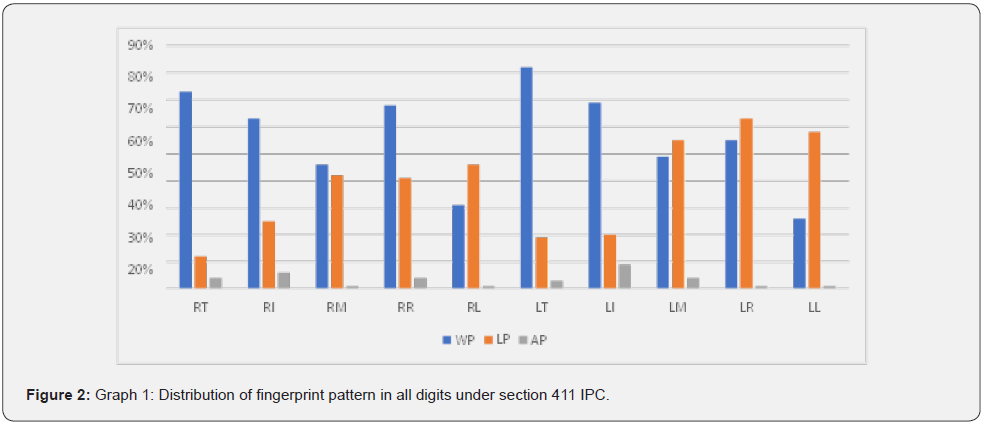
In this finding, the left thumb has the maximum no. of whorl pattern type is 82% and the left little has the minimum no. of whorl pattern type is 26%. Similarly, if we look at the analyzed data in the case of loop patterns, we have the maximum no. of loop patterns seen in the left ring finger is 63% and the minimum is seen in the right thumb is 12%. The maximum no. of arch pattern type is found in right and left index is 9% and minimum no of arch pattern type is seen in right middle, right little, left ring, and left little is 1%. In this finding, the right thumb has the maximum no. of whorl pattern type that is 197 and the percentage is 71% and the left little has the minimum no. of whorl pattern type is 15%. Similarly, if we look at the analyzed data in the case of loop patterns, we have a maximum no. of loop patterns seen in the right little finger is 78% and the minimum is seen in the right thumb is 19%. The maximum no. of arch pattern types found in a left index is 17% and the minimum no of arch patterns typically seen in the right little is 1% Figure 3.

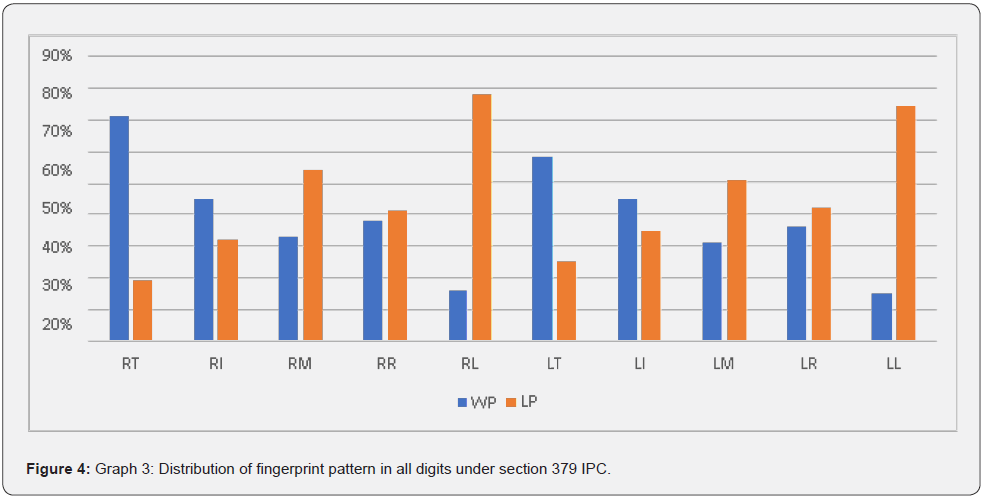
In this finding the right thumb has the maximum no. of whorl pattern type is 70% and the right middle, left middle and left little has the minimum no. of whorl pattern type is 37%. Similarly, if we look at the analyzed data in the case of loop patterns, we have the maximum no. of loop patterns seen in the right little finger is 65% and the minimum is seen in the right thumb is 13%. The maximum no. of arch pattern typically found in the right ring is 3% and the minimum no of arch pattern typically seen in the left little is 9%. In this finding, the left thumb has the maximum no. of whorl pattern type is 70% and the left little has the minimum no. of whorl pattern type is 14%. Similarly, if we look at the analyzed data in the case of loop patterns, we have the maximum no. of loop patterns seen in the right thumb finger is 68% and the minimum is seen in the right little and left thumb is 23%. The maximum no. of arch pattern types found in the left index is 12% and the minimum no of arch pattern types is seen in the right thumb, right little, right ring, and right little which is 1% Figure 4.
In this finding, the left thumb has the maximum no. of whorl pattern type is 51% and the left little has the minimum no. of whorl pattern type is 12%. Similarly, if we look at the analyzed data in the case of loop patterns, we have the maximum no. of loop patterns seen in the left little finger is 67% and the minimum is seen in the right little and left thumb which is 23%. The maximum no. of arch pattern typically found in the left index is 9% and the minimum no of arch pattern type is seen in the right thumb, right ring, right little, and left little is 0%.
In this finding, the right thumb has the maximum no. of whorl pattern is 76% and the right little has the minimum no. of whorl pattern type is 22%. Similarly, if we look at the analyzed data in the case of loop patterns, we have a maximum no. of loop patterns seen in the right little finger 76% and the minimum is seen in the right thumb which is 16%. The maximum no. of arch pattern type is found in the left index is 22% and the minimum no of arch pattern type is seen in the right little is 0.09 Figure 5.
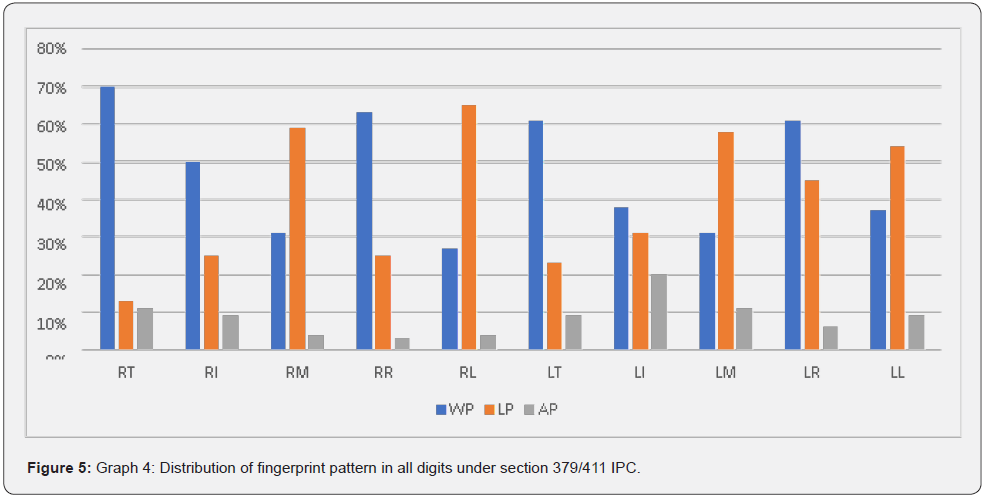
Graph 8: Distribution of Fingerprint Patterns in Non- Convicted Criminals
In this finding the left thumb has the maximum no. of patterns is 76% and the right little has the minimum no. of patterns found is 22%. Similarly, if we look at the analyzed data in the case of loop patterns, we have a maximum no. of loop patterns seen in the right little finger which is 76% and the minimum is seen in the right thumb which is 16%. The maximum no. of the arch is seen in the right index at 15% and minimum no of arch pattern type is seen in the right thumb, right ring, and right little is 2% Figure 6.
In this finding, the left and right hand that the formation of double loop pattern type is highest that ranges from 13% to 0.09% as compared to the twinned loop fingerprint pattern type which is lowest in percentage 6% to 0.09%. The central pocket loop has a percentage ranging from 9% to 2%. In this finding, the left and right hands that the formation of the ulnar loop pattern type is highest ranging from 72% to 12% as compared to the radial loop fingerprint pattern type which is lowest in percentage 25% to 0.2% Figure 7-9.
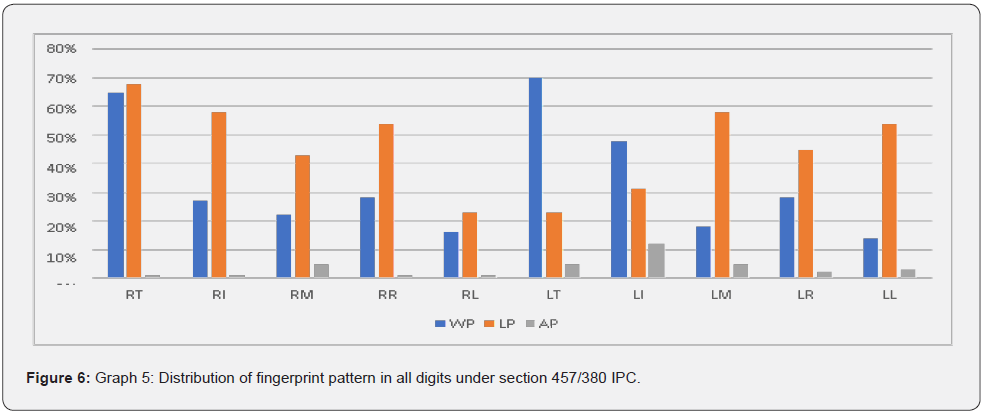

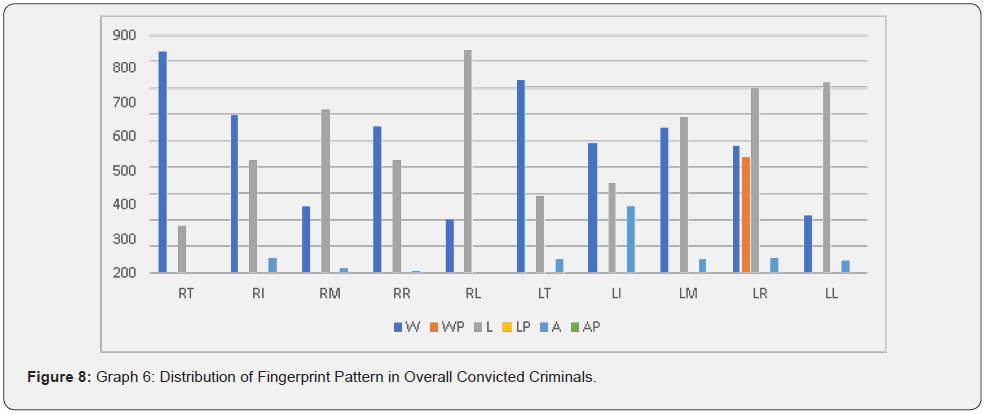
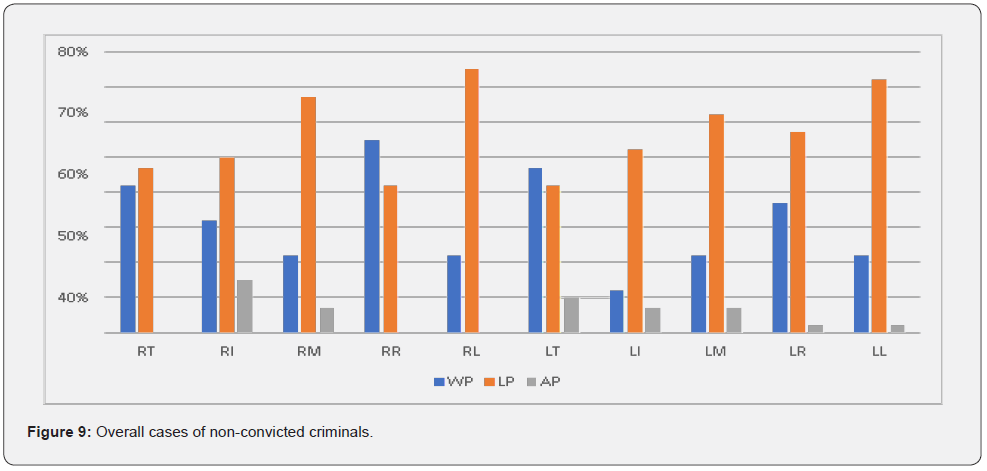
Discussion
In this study, a total of 1100 fingerprints collected by taping method of both left and right hands including all 10 digits that revealed the whorls as well as the whorl as the most common pattern found but the arches pattern is least found pattern. This finding was consistent with the study whorls and the loops were 82% and 76% respectively. Though slight differences occurred in the patterns of arches and reported 22% in convicted criminals. In observation of the fingerprint pattern distribution in our study, all three patterns were found to be in higher frequencies in males. But as the data we collected was not sufficient in the case of convicted criminals so we can say that it cannot be decided.
In 129 cases of convicted criminals under section 411 IPC, we observed that the maximum no of whorl pattern type with 68% is found and minimum no of arches pattern type with 2% is found. In 63 cases of convicted criminals under section 380 IPC, we observed that maximum no of whorl pattern type with 82% is found and minimum no of arches pattern type with 1% is found. In 277 cases of convicted criminals under section 379 IPC, we observed that maximum no of loop pattern type with 74% is found and minimum no of arches pattern type with 4% is found. In 44 cases of convicted criminals under section 379 /411 IPC, we observe that maximum no of whorl pattern type with 70% is found and minimum no of arches pattern type with 3% is found. In 85 cases of convicted criminals under section 457/380 IPC, we observe that maximum no of whorl pattern type with 68% is found and minimum no of arches pattern type with 1% is found. In 74 cases of convicted criminals under section 109 CRPC, were observed that maximum no of loop pattern type with 64% is found and minimum no of arches pattern type with 0% is found. Looking into the subtypes of loops and whorls, the double loop whorl was slightly more common (21%) than the central pocket loop (9%) and twinned loop (6%) whereas the ulnar loop was more (72%) than the radial loop (25%). Amongst the arches, the tented arch is more frequently found (16%) than the plain arch (3.4%).
Conclusion
From the study of 1100 samples of 10 digits fingerprint patterns of convicted criminals. We may conclude that irrespective of digit whether from the right hand and left-hand percentage of whorl pattern is found in highest percentage is range from 76% to 18%. The recorded data confirms that from the 10 digits of the right-hand and left-hand percentage of arch pattern is the lowest arch from 0.09% to 22%. In the case of loop patterns from the 10 digits of right and left hands 16% to 76% which is almost similar to the whorl pattern. As far as the sentence (411IPC, 380 IPC, 379 IPC, 379/411 IPC, and 109 CRPC) is concerned under which criminals are convicted. There is no marked relation that can be established with the fingerprint pattern of the convicted criminals. Loop pattern is the most found pattern and then the whorl and the arches.
It may be inferred due to the least surface area of the upper phalanges index, middle, ring, little the whorl pattern is found least in number whereas the surface area of upper phalanges of thumb is remarkably bigger than other four fingers and then whorl pattern is found highest in number or other words the possibility of formation of whorl pattern is highest due to its bigger surface area.
This study was conducted to study various patterns of fingerprints and their distribution among males and females of non-convicted criminals. In non- convicted criminals we observed at both right and left hand the pattern type and fingerprint distribution are almost same hence it is not a definite parameter. we see the male has a maximum whorl pattern found in the thumb (32%) and a minimum no of whorl pattern is found in middle (15%), but the female has a maximum no of whorl pattern in the ring (20%) and minimum no of whorl pattern type in right little, left index, left middle (5%).
The Male has a maximum no of loop pattern in the right middle (60%) and minimum no of loop pattern in the thumb (32%), but the female has a maximum no of loop pattern in the little finger (22%) and minimum no of loop pattern in the right ring (5%). In males, the arch pattern type is maximum in the index finger (15%) and minimum in the ring and little finger, but the female thumb and the index have a maximum no of arch and middle, ring, little (2%) has a minimum no. of the arch pattern type recorded that is (0).
References
- Caplan RM (1990) How fingerprints came into use for personal identification. J Am Acad Dermatol 23(1): 109-114.
- Awuah D, Dzogbefia VP, Chattopadhyay PK (2017) Finger dermatoglyphics of the Asante population of Ghana. International Journal of Innovative Research and Advanced Studies 4(4): 333-336.
- Daluz HM (2018) Fundamentals of fingerprint analysis. CRC Press, USA.
- Ag VK, Suresh J (2020) Study of Fingerprint Pattern: A Cross-Sectional Study 20(4): 41456.
- Brunda S (2020) Fingerprint Recognition and Analysis. Pp.
- Bhavana D, Ruchi J, Prakash T, JL K (2013) Study of fingerprint patterns in relationship with blood group and gender-a statistical review, Arches 1(1): 15-17.
- Mange AP, Mange EJ (1990) Genetics: Human Aspects 2nd Sinauer Associates: Sunderland, Massachusetts.
- Bansal HD, Hansi D, Badiye AD, Kapoor NS (2014) Distribution of fingerprint patterns in an Indian population. Malaysian Journal of Forensic Sciences 5(2): 18-21.
- Kaur M (2019) Fingerprint Ridge Density of Convicted Male and Females Prisoners: A Pilot Study. Brazilian Journal of Forensic Sciences, Medical Law, and Bioethics 8(4): 226-234.
- Kaur M, Kaur M, Kamal P, Kaur J (2019) worked on Digital Dermatoglyphic Patterns of Convicted Prisoners: A Comparative Cohort-Control Study 1(10): 1403-1411.
- Kanchan T, Chattopadhyay S (2006) Distribution of fingerprint patterns among medical students. Journal of Indian Academy of Forensic Medicine 28(2): 65-68.
- Butt US, Iqbal A, Akhtar N, Qazi S, Ali Z, et al. (2021) Dermatoglyphics Association with Criminal Intent. Pakistan Journal of Physiology 17(2): 35-37.
- Pandey A, Vyas JM (2014) A comparative case study of fingerprint patterns in male convicts of Sabarmati jail (Ahmedabad) in Gujarati population. Indian Journal of Forensic Medicine & Toxicology 8(1): 1.
- Sangero B, Halpert M (2007) Why a conviction should not be based on a single piece of evidence: A proposal for reform. Jurimetrics 48: 43-94.
- Khadri SY, Goudar ES, Khadri SY (2013) A study of fingerprint pattern and gender distribution of fingerprints in and around Bijapur. Al Ameen J Med Sci 6(4): 328-331.
- Millogo M, Ouattara S, Salou N, Zeba M, Ouedraogo A, et al. Distribution of Fingerprints Patterns Among a Cohort of Population in Ouagadougou, Burkina Faso, Africa.
- Richard Neku, Kiekwe V, Olawepo A (2021) Relationship between whorls dermatoglyphic patterns and handedness amongst students of tertiary institutions in Ilorin Nigeria. Cumhuriyet Medical Journal 43(4): 339-345.
- Matyas J (1999) Dermatoglyphic analysis of male criminals.
- Ag VK, Suresh J (2020) Study of Fingerprint Pattern: A Cross-Sectional Study 20(4): 41456.
- Rakesh M Marigoudar, Chinmayi (2020) Study of fingerprint pattern among south Indian population- a cross sectional study, Medplus international journal of forensic science medicine 15(1): 1-6.
- Shrestha Iju, Banshi Krishna M (2019) Study of fingerprint patterns in the population of a community. JNMA J Nepal Med Assoc 57(219): 293-296.






























